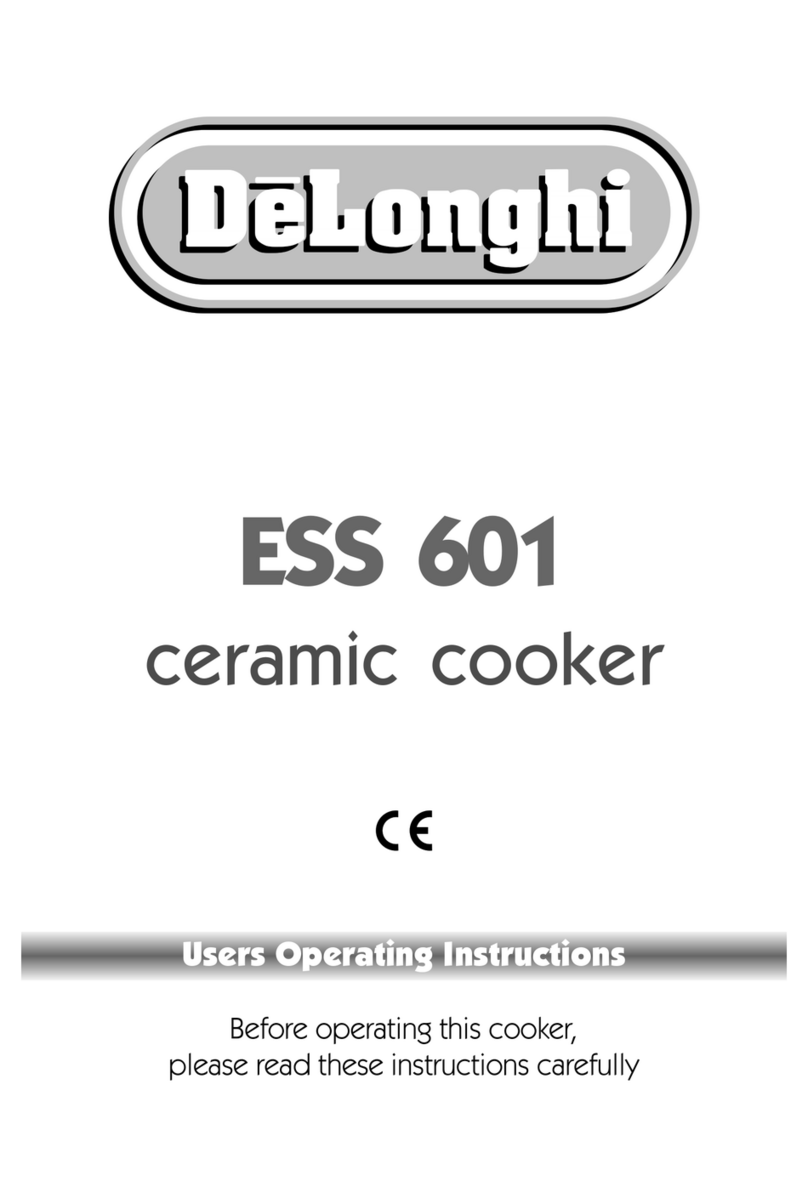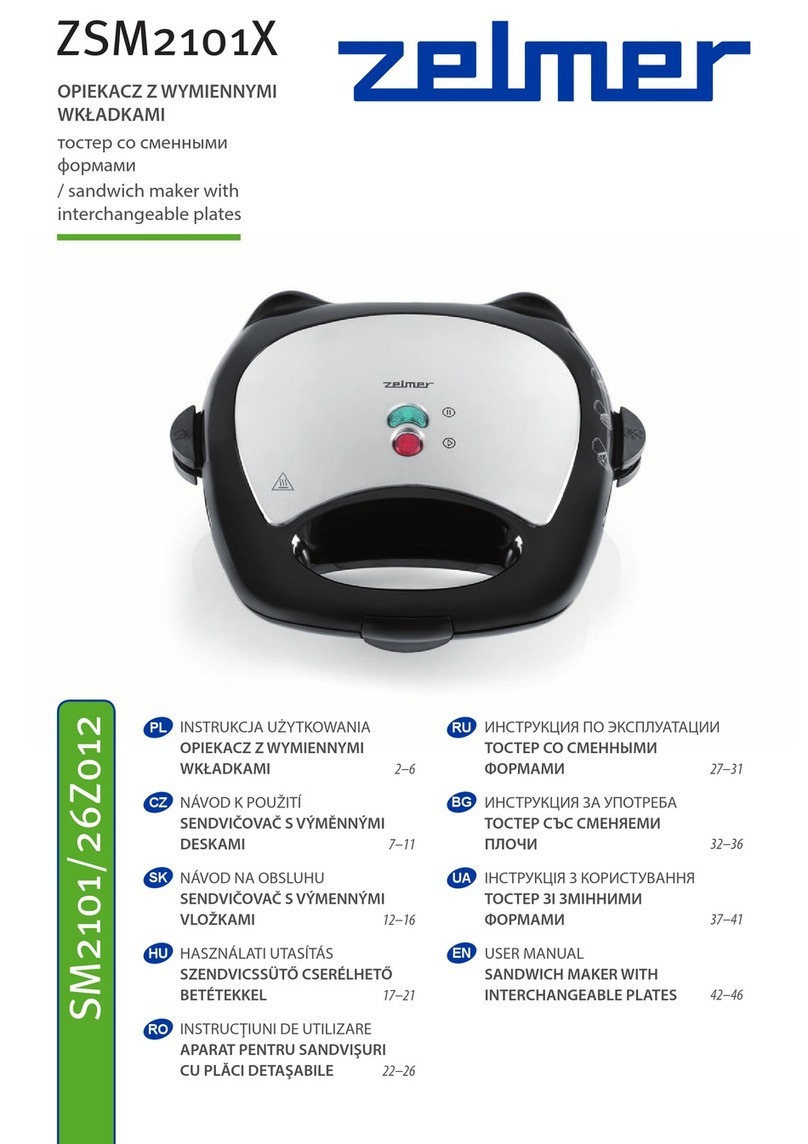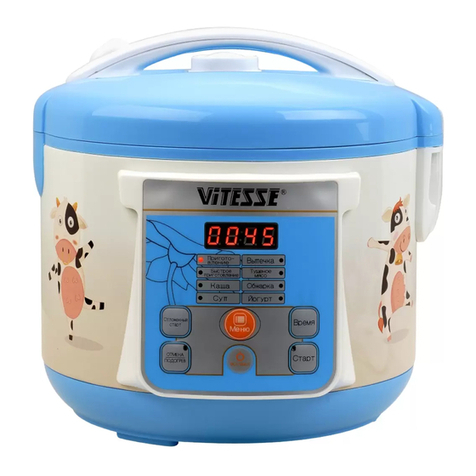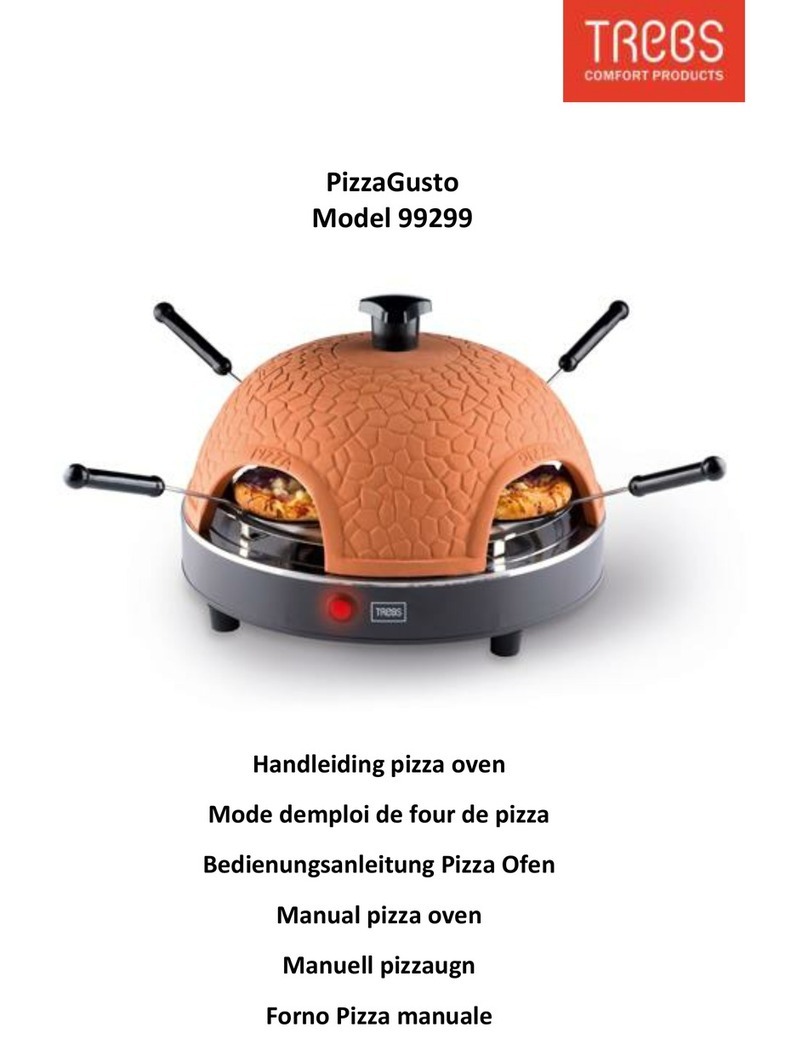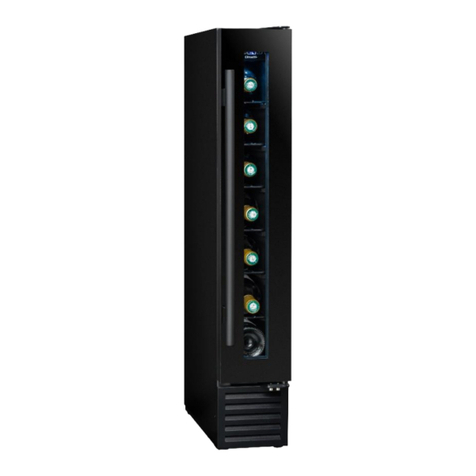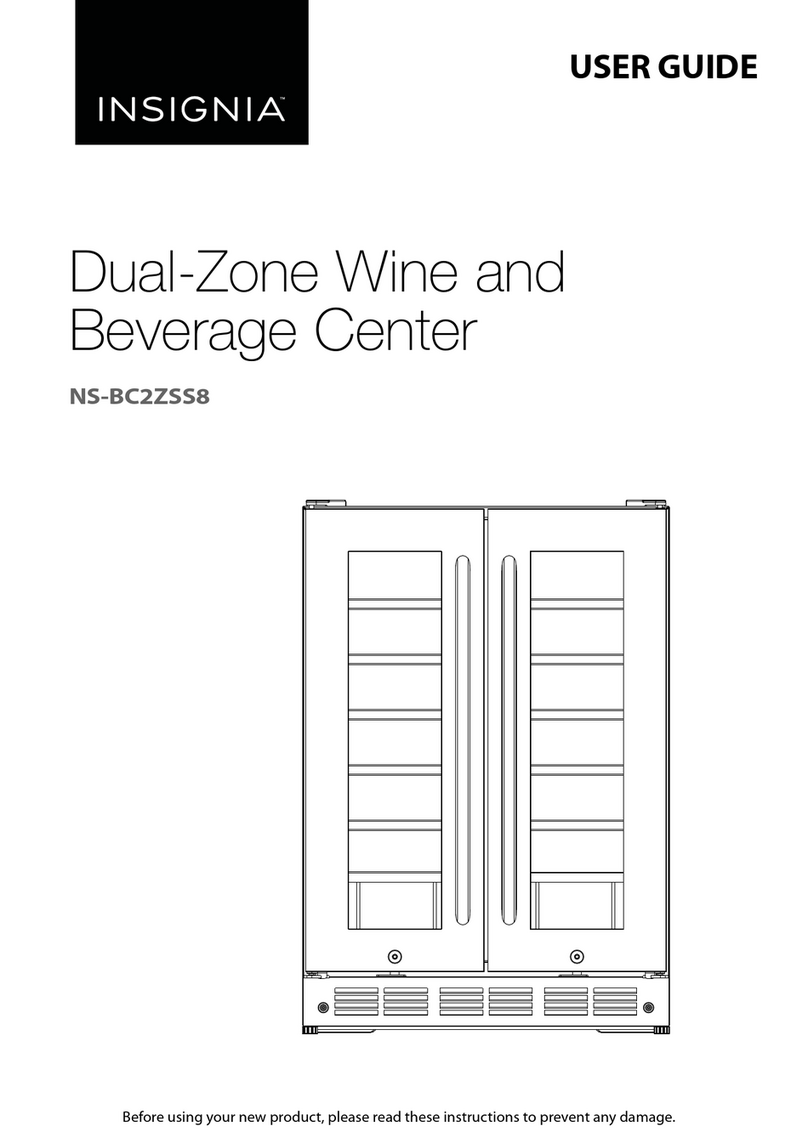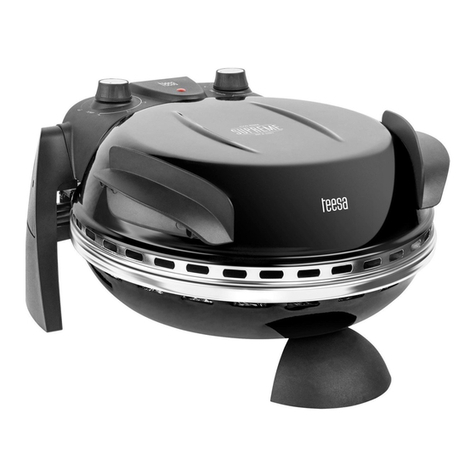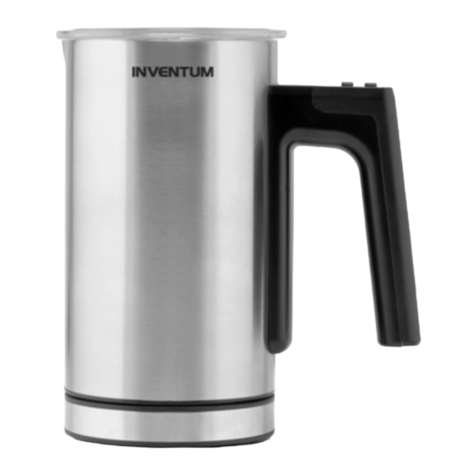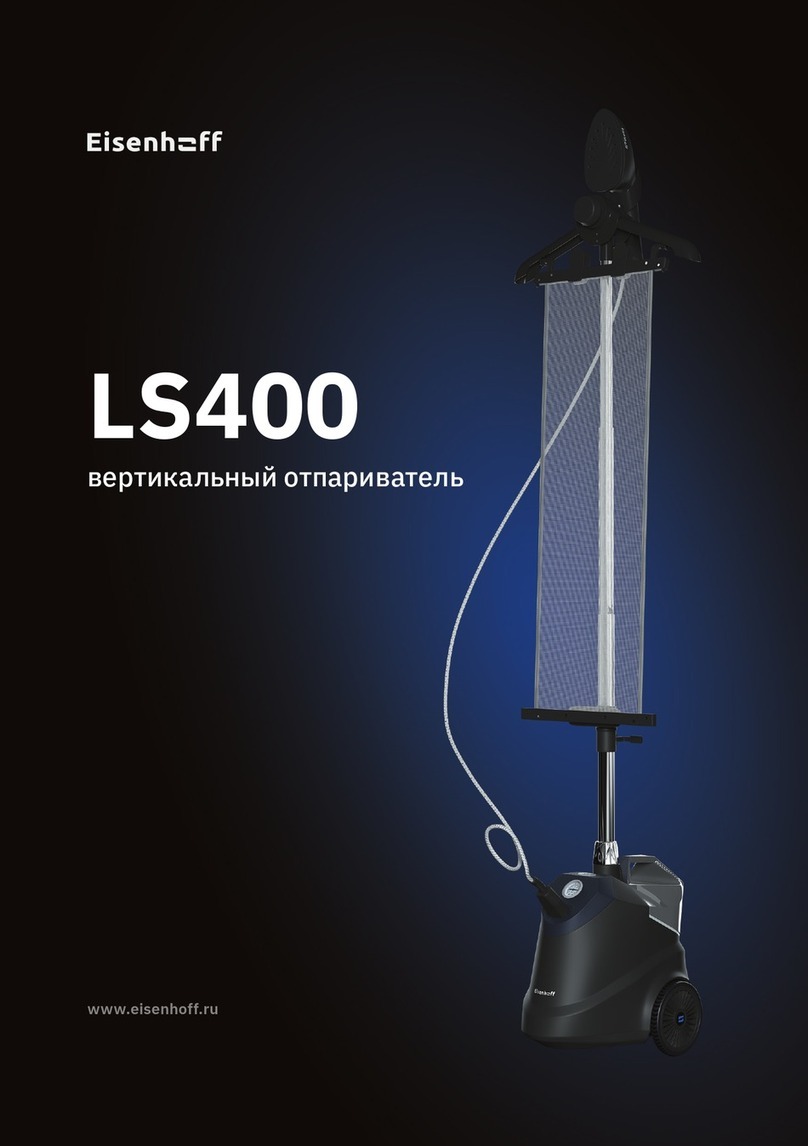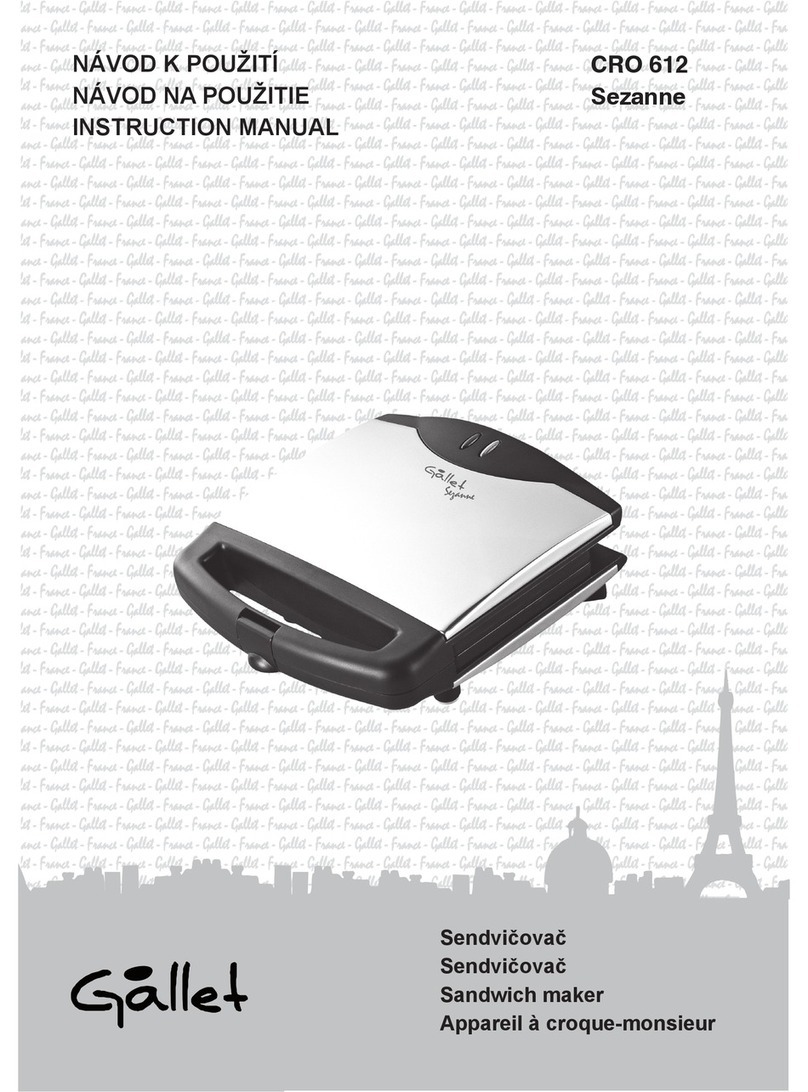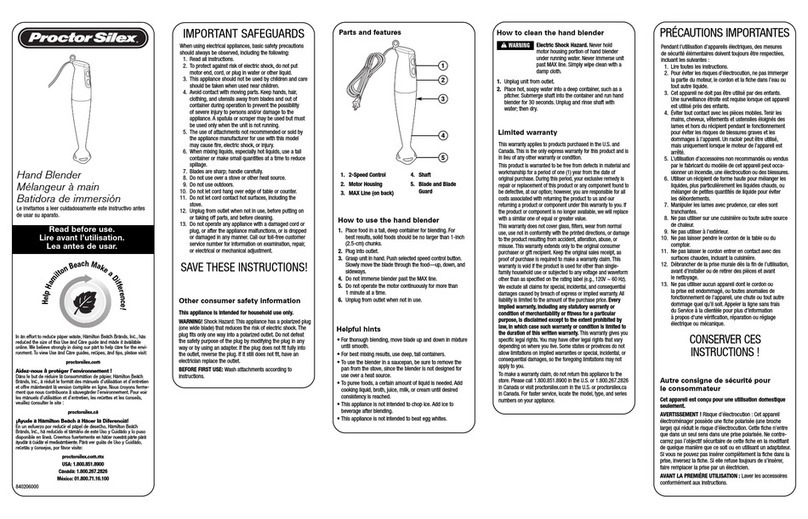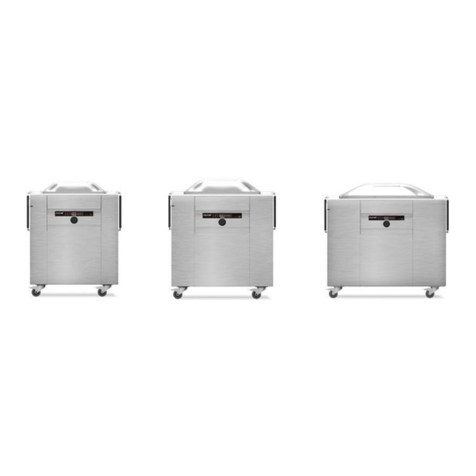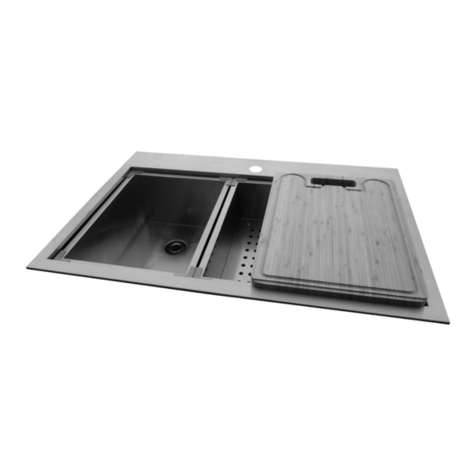DèLonghi DTC 90 DF Operation instructions

DTC 90 DF
Twin cavity
Dual Fuel Cooker
Users Operating Instructions
Before operating this cooker,
please read these instructions carefully
GB

2
Congratulations on your purchase of this Delonghi Dual fuel cooker which has
been carefully designed and produced to give you many years of satisfactory use.
Before using this appliance it is essential that the following instructions are carefully
read and fully understood.
We would emphasise that the installation section must be fully complied with for your
safety to ensure that you obtain the maximum benefits from your appliance.
Important:
This appliance is designed and manufactured solely for the cooking of domestic
(household) food and is not suitable for any non domestic application and there-
fore should not be used in a commercial environment.
The appliance guarantee will be void if the appliance is used within a non domes-
tic environment i.e. a semi commercial, commercial or communal environment.
Introduction

3
IMPORTANT INFORMATION FOR CORRECT DISPOSAL OF THE
PRODUCT IN ACCORDANCE WITH EC DIRECTIVE 2002/96/EC.
At the end of its working life, the product must not be disposed of as
urban waste. It must be taken to a special local authority differentiat-
ed waste collection centre or to a dealer providing this service.
Disposing of a household appliance separately avoids possible nega-
tive consequences for the environment and health deriving from inap-
propriate disposal and enables the constituent materials to be recov-
ered to obtain significant savings in energy and resources. As a
reminder of the need to dispose of household appliances separately,
the product is marked with a crossed-out wheeled dustbin.
Declaration of CE conformity
✓
This cooker has been designed, constructed and marketed in compliance with:
- Safety requirements of EU Directive "Gas" 90/396/EEC;
- Safety requirements of EU Directive "Low Voltage" 2006/95/EC;
- Protection requirements of EU Directive "EMC" 89/336/EEC;
- Requirements of EU Directive 93/68/EEC.
GB
IMPORTANT INSTRUCTIONS AND ADVICE FOR THE USE OF
ELECTRICAL APPLIANCES
The use of any electrical appliance requires the compliance with some basic rules,
namely:
– do not touch the appliance with wet or damp hands (or feet)
– do not use the appliance whilst in bare feet
– do not allow the appliance to be operated by children or unqualified persons
without supervision.
The manufacturer cannot be deemed responsible for damages caused by wrong or
incorrect use.

4
IMPORTANT SAFEGUARDS AND RECOMMENDATIONS
After having unpacked the appliance, check to ensure that it is not damaged.
In case of doubt, do not use it and consult your supplier or a professionally qualified
technician.
Packing elements (i.e. plastic bags, polystyrene foam, nails, packing straps, etc.) should
not be left around within easy reach of children, as these may cause serious injuries.
■ATTENTION: please peel plastic cover off both sides and front of the cooker
before use.
■Do not attempt to modify the technical characteristics of the appliance as this may
cause danger to users.
■Do not carry out any cleaning or maintenance operations on the appliance without
first disconnecting it from the electric power supply.
■If you should decide not to use this appliance any longer (or decide to substitute an
older model), before disposing of it, it is recommended that it is made inoperative in
an appropriate manner in accordance to health and environmental protection regula-
tions, ensuring in particular that all potentially hazardous parts be made harmless,
especially in relation to children who could play with unused appliances.
■After use, always ensure that the control knobs are in the off position.
■The appliance is not intended for use by young children or infirm persons unless they
have been adequately supervised by a responsible person to ensure that they can use
the appliance safely.
■During and after use of the cooker, certain parts will become very hot. Do not touch
hot parts.
■Young children should be supervised to ensure that they do not play with the appli-
ance.
■Some appliances are supplied with a protective film on steel and aluminium parts.
This film must be removed before using the appliance.
■WARNING
When correctly installed, your product meets all safety requirements laid down
for this type of product category. However special care should be taken around
the rear or the underneath of the appliance as these areas are not designed or
intended to be touched and may contain sharp or rough edges, that may cause
injury.
■Fire risk! Do not store flammable material in the ovens.
■Make sure that electrical cords connecting other appliances in the proximity of
the cooker cannot come into contact with the hob or become entrapped in the
oven door.
■Do not line the oven walls with aluminium foil. Do not place baking trays or the
drip tray on the base of the oven chamber.
■The manufacturer declines all liability for injury to persons or damage to proper-
ty caused by incorrect or improper use of the appliance.

5
■The various components of the appliance are recyclable. Dispose of them in
accordance with the regulations in force in your country. If the appliance is to
be scrapped, remove the power cord.
■Always use oven gloves when removing the shelves and food trays from the
oven whilst hot.
■Do not hang towels, dishcloths or other items on the cooker or its handle – as
this could be a fire hazard.
■Clean the oven regularly and do not allow fat or oils to build up in the oven
base or trays. Remove spillages as soon as they occur.
■Do not stand on the cooker or on the open oven door.
■Always stand back from the cooker when opening the oven door to allow
steam and hot air to escape before removing the food.
■This appliance is for domestic use only.
■WARNING: Taking care NOT to lift the cooker by the door handles.
■Safe food handling: leave food in the oven for as short a time as possible
before and after cooking. This is to avoid contamination by organisms which
may cause food poisoning. Take particular care during warmer weather.

6
2
4
2
1
3
Fig. 1.1
Cooking hob
1
1
COOKING HOB
1. Auxiliary burner (A) 1,00 kW
2. Semi-rapid burner (SR) 1,75 kW
3. Rapid burner (R) 3,00 kW
4. Triple-ring burner (TR) 3,50 kW
Important Note:
The electric ignition is incorporated in the knobs.

7
A
U
T
O
12 45 78910
CONTROL PANEL - Controls description
1. Electronic clock/end cooking timer (main left oven only)
2. Fan main oven thermostat knob
3. Fan main oven switch knob
4. Front left burner control knob
5. Rear left burner control knob
6. Central burner control knob
7. Rear right burner control knob
8. Front right burner control knob
9. Conventional oven switch knob
10. Conventional oven thermostat knob
Pilot lamps:
11. Main oven thermostat indicator light
12. Conventional oven thermostat indicator light
3
11 12
Fig. 2.1
6
Control panel
2
2
Please note: This appliance incorporates a safety cooling fan which you will hear
operating whenever the oven or grill are in use. This fan is to reduce the external
temperature of the appliance and cool the internal components.

8
A
U
T
O
The electronic programmer is a device with the following functions:
– 24 hours clock with illuminated display
– Timing of oven cooking with automatic switch-off (max. 99 minutes).
ELECTRONIC CLOCK
Upon immediate connection of the oven or after a mains failure, three zeros will flash
on the programmer panel.
To set the clock it is necessary to push the button and then, within 7 seconds, the
or button until you have set the correct time.
The clock will show zero after a mains failure.
Attention: When the programmer display shows three flashing zeros the oven cannot
be switched on.
The oven can be switched on when the symbol is shown in the display.
SETTING THE FREQUENCY OF THE ALARM SOUND
The selection from 3 possibilities of sound can be made by pressing the button.
Fig. 3.1
Electronic clock/end cooking timer
3
3
(main left oven only)

9
COOKING WITH AUTOMATIC SWITCH-OFF (main left oven only)
The aim of this function is to automatically stop the cooking after a pre programmed
time, for a maximum period of 99 minutes.
To set the cooking time, push the or button until you obtain the desired time in
the display. The symbol AUTO will be shown in the display. Then you adjust the oven
thermostat knob according to the required temperature. The oven will immediately
start to operate and will work for the pre programmed time. The display shows the
count down. Clock time can be displayed by pressing the button. Once the time
has elasped, the oven will switch off automatically, the symbol AUTO will go off and an
intermittent buzzer, lasting 7 minutes, will start; this can be stopped by pressing the
button.
Important: Before the buzzer is stopped switch off the oven manually.
To cancel the cooking program at any time press the and buttons together and
release the button first.
ELECTRONIC ALARM
The programmer can be used as an alarm only for a maximum period of 99 minutes. To set
the alarm, push the or button until you obtain the desired time in the display. Once
the time has elasped, an intermittent buzzer, lasting 7 minutes, will start; this can be
stopped by pressing the button.
Attention: If the bottom oven is switched on when the buzzer starts, it will be
automatically switched off. For it to operate furtherly you have to stop the
buzzer by pressing the button.

10
HOB BURNERS
Each hob burner is controlled by a sep-
arate gas tap operated by a control
knob (fig. 4.1) which has 3 positions
marked on the control panel, these are:
– Symbol 0: tap closed (burner off)
– Symbol : High (maximum)
– Symbol : Low (minimum)
Push in and turn the knob anti-
clockwise to the selected position.
Low High
To turn the burner off, fully rotate the knob clockwise to the off position: 0.
The maximum setting of the control tap is for boiling, the minimum setting is for slow
cooking and simmering.
All working positions must be choosen between the maximum and minimum setting,
never between the maximum setting and the “OFF” position.
Fig. 4.1
Electric ignition
The sparks generated by the electrodes close to the burners will ignite the
choosen burner. Whenever the lighting of the burners is difficult due to peculiar
conditions of the gas features or supply, it is advised to repeat the ignition with
the knob on “minimum” position.
How to use the hob burners
4
4

11
CHOICE OF THE BURNER
On the control panel, near each knob, there is a diagram that indicates which burner
is controlled by that knob.
Select the burner that is most suitable for the diameter and capacity of the pan to be
used.
As an indication, the burners and the pans must be used in the following way:
It is important that the base diameter of the pot is at least the same diameter as the
burner ring to obtain an efficient heat transfer.
Always position pans centrally over the burners.
Adjust the size of the flame so that it does not lick up the side of the pan.
Position pan handles so that they cannot be accidentally knocked.
Fig. 4.2
BURNERS POT DIAMETER
Auxiliary 12 - 14 cm
Semi-rapid 16 - 24 cm
Rapid 24 - 26 cm
Triple-ring 26 - 28 cm
do not use pans with concave or convex bases
LIGHTING THE BURNERS
To ignite the burner, the following instructions are to be followed:
1) Lightly press and turn the knob anti-clockwise, and position the knob indicator to the
symbol printed on the control panel (fig. 4.1).
2) Press the knob to operate the electric ignition; or, in the case of a mains failure light
the burner with a match or lighted taper.
3) Adjust the burner according to the setting required.

12
GENERAL FEATURES
The heating and cooking in electrical
hot air ovens take place by forced con-
vection.
The two elements which make this
process take place are:
- Circular element 2500 W
- Grill element 2000 W
NOTE:
Upon first use, it is advisable to operate
the oven at the maximum temperature
(thermostat knob on position 250) for
60 minutes in the position (fan
oven) and for another 15 minutes in the
position (thermostat knob on posi-
tion 200°C), to eliminate possible traces
of grease on the heating elements.
WARNING:
The door is hot, use the handle.
ATTENTION - MOST IMPORTANT
Pay special attention not to touch
the hot heating element inside the
oven cavity.
OPERATING PRINCIPLES
Heating and cooking in the FAN oven
are obtained in the following ways:
a. by forced convection
A fan sucks in the air contained in the
oven muffle, which sends it through
the circular heating element and then
sends it back through the muffle.
Before the hot air is sucked back
again by the fan to repeat the
described cycle, it envelops the food
in the oven, provoking a complete
and rapid cooking.
It is possible to cook several dishes
simultaneously.
b. by radiation
The heat is radiated by the infra red
grill element.
c. by ventilation
The food is defrosted by using the fan
only function without heat.
Left main Fan oven
5
5
Attention: the oven door
becomes very hot during opera-
tion. Keep children away.

13
Fig. 5.1 Fig. 5.2
FUNCTION SELECTOR KNOB (Fig. 5.2)
Rotate the knob clockwise to set the oven for one of the following functions.
THERMOSTAT KNOB (Fig. 5.1)
This only sets the cooking temperature and does not switch the oven on. Rotate clock-
wise until the required temperature is reached (from 50 to 250°C).
The light above the temperature selector will illuminate when the oven is swiched on
and turns off when the oven reaches the correct temperature.
The light will cycle on and off during cooking in line with the oven temperature.
OVEN LIGHT
By setting the knob to this position, only the oven light comes on.
It remains on in all the cooking modes.
DEFROSTING FROZEN FOODS
Only the oven fan comes on. Use with the thermostat knob set to “0” - other positions
have no effect. The food is thawed by ventilation without heating.
Recommended for:
Quick thawing of frozen foods; one kg requires approximately 1 hour.
Thawing times vary according to the quantity and type of food to be thawed.

14
COOKING ADVICE
STERILIZATION
Sterilization of foods to be conserved, in full and hermetically sealed jars, is done in the
following way:
a. Set the switch to position .
b. Set the thermostat knob to position 185 °C and preheat the oven.
c. Fill the dripping pan with hot water.
d. Set the jars onto the dripping pan making sure they do not touch each other and
the door and set the thermostat knob to position 135 °C.
When sterilization has begun, that is, when the contents of the jars start to bubble,
turn off the oven and let cool.
HOT AIR COOKING
The circular element and fan come on. The heat is dispersed by forced convection
and the temperature can be regulated to between 50° and 250°C via the
thermostat knob. The oven does not require preheating.
Recommended for:
Food which has to be well-cooked outside and soft or rosy inside, for example
lasagne, lamb, roast beef, whole fish etc.
GRILLING
The infrared grill element comes on. The heat is dispersed by radiation.
Set the thermostat knob to between 50° and 200°C.
Always grill with the oven door closed.
For cooking hints, see the chapter “USE OF THE GRILL”.
Recommended for:
Intense grilling, browning, cooking au gratin and toasting etc.
Do not grill for longer than 30 minutes at any one time on full heat (200°C).
Caution: the oven door becomes very hot during operation.
Keep children well out of reach.

15
USE OF THE GRILL
Preheat the oven for about 5 minutes.
Introduce the food to be cooked, positioning the rack as close to the grill as possible.
The dripping pan should be placed under the rack to catch the cooking juices and fats.
Grilling with the oven door closed.
Do not grill for longer than 30 minutes at any one time on full heat (200°C).
Caution: the oven door becomes very hot during operation.
Keep children well out of reach.
ROASTING
To obtain classical roasting, it is necessary to remember:
– that it is advisable to maintain a temperature between 180° and 200 °C.
– that the cooking time depends on the quantity and the type of foods.
REGENERATION
Set the switch to position and the thermostat knob to position 150° C.
Bread becomes fragrant again if wet with a few drops of water and put into the oven
for about 10 minutes at the highest temperature.
SIMULTANEOUS COOKING OF DIFFERENT FOODS
The FAN consents a simultaneous heterogeneous cooking of different foods. Different
foods such as fish, cake and meat can be cooked together without mixing the smells
and flavors together. This is possible since the fats and vapors are oxidized while pass-
ing through the electrical element and therefore are not deposited onto the foods.
The only precaution to follow are:
– The cooking temperatures of the different foods must be as close to as possible, with
a maximum difference of 20° - 25 °C.
– The introduction of the different dishes in the oven must be done at different times in
relation to the cooking times of each one.
The time and energy saved with this type of cooking is obvious.

16
THERMOSTAT KNOB (Fig. 6.2)
This only sets the cooking temperature
and does not switch the oven on.
Rotate clockwise until the required tem-
perature is reached (from 50 to 250°C).
The light above the temperature selector
will illuminate when the oven is swiched
on and turns off when the oven reaches
the correct temperature.
The light will cycle on and off during
cooking in line with the oven tempera-
ture.
GENERAL FEATURES
The conventional oven is provided with 3
heating elements which are:
– Bottom element 800 W
– Top element 700 W
– Grill element 1450 W
NOTE:
Upon first use, it is advisable to operate
the oven at the maximum temperature
(thermostat knob on position 250) for
60 minutes in the position and for
another 15 minutes in the position
(thermostat knob on position 200°C),
to eliminate possible traces of grease on
the heating elements.
WARNING:
The door is hot, use the handle.
ATTENTION - MOST IMPORTANT
Pay special attention not to touch
the hot heating element inside the
oven cavity.
Fig. 6.1 Fig. 6.2
Right small Conventional oven
6
6
Attention: the oven door
becomes very hot during opera-
tion. Keep children away.
OPERATING PRINCIPLES
Heating and cooking in the CONVEN-
TIONAL oven are obtained in the fol-
lowing ways:
a. by natural convection
The heat is produced by the upper
and lower heating elements.
b. by radiation
The heat is radiated by the infra red
grill element.

17
TRADITIONAL CONVECTION COOKING
The upper and lower heating elements come on.
The heat is dispersed by natural convection and the temperature must be set to
between 50° and 250°C via the thermostat knob. The oven must be preheated before
cooking.
Recommended for:
Food that requires the same degree of cooking both inside and out, for example
roasts, spare pork ribs, meringues etc.
FUNCTION SELECTOR KNOB (Fig. 6.1)
Rotate the knob clockwise to set the oven for one of the following functions.
OVEN LIGHT
By setting the knob to this position, only the oven light comes on.
It remains on in all the cooking modes.
GRILLING
The infrared grill element comes on. The heat is dispersed by radiation.
Set the thermostat knob to between 50° and 200°C.
Always grill with the oven door closed.
For cooking hints, see the chapter “USE OF THE GRILL”.
Recommended for:
Intense grilling, browning, cooking au gratin and toasting etc.
Do not grill for longer than 30 minutes at any one time on full heat (200°C).
Caution: the oven door becomes very hot during operation.
Keep children well out of reach.
USE OF THE GRILL
Preheat the oven for about 5 minutes.
Introduce the food to be cooked, positioning the rack as close to the grill as possible.
The dripping pan should be placed under the rack to catch the cooking juices and fats.
Grilling with the oven door closed.
Do not grill for longer than 30 minutes at any one time on full heat (200°C).
Caution: the oven door becomes very hot during operation.
Keep children well out of reach.

18
APPROX. HEAT OF TYPE OF DISH TO COOK
TEMPERATURE OVEN
125°C Very cool Meringue,
(257°F) oven slow cooking foods.
135°C - 140°C Cool or Milk puddings, very rich fruit
(275°F - 285°F) slow oven cakes, eg., Christmas.
150°C Cool or Stews, casseroles, braising,
(300°F) slow oven rich fruit cakes, eg., Dundee.
160°C - 170°C Warm oven Biscuits, Low temperature roasting,
(320°F - 338°F) rich plain cakes eg., Madeira cake.
180°C Moderate Plain cakes, eg., Victoria
(356°F) oven sandwich, meat pies.
190°C Fairly hot Small cakes, savoury flans,
(374°F) oven fish.
200°C Hot oven Plain cakes and buns, swiss rolls,
(392°F) fruit pies. High temp. roasting.
215°C Moderately Bread and bread rolls etc., scones,
(419°F) hot oven flaky and rough puff pastry,
Yorkshire pudding.
225°C Very hot Sausage rolls, mince pies, puff
(437°F) oven pastry.
Browning ready cooked dishes.
Temperature and times given are approximate, as they will vary depending on the quality
and amount of food being cooked.
Remember to use ovenproof dishes and to adjust the oven temperature during cooking
if necessary.
Cooking guide
7
7

19
Installation, and any demonstration, information or adjustments are not included in
the warranty.
The cooker must be installed by a qualified person in accordance with the relevant
Standards.
In the UK C.O.R.G.I registered installers are authorised to undertake the installation and
service work in compliance with the above regulations. All Comet authorised installers
are C.O.R.G.I. registered.
Attention
The appliance gets very hot, mainly around the cooking areas. It is very
important that children are not left alone in the kitchen when you are
cooking.
AFTER SALES SERVICE
Should you require to book a service call telephone 0870 5425425.
For product information and advise telephone 0113 2793520
Important notes

20
• Do always grill with the ovens door closed.
• Do read the user instructions carefully before using the cooker for first time.
• Do allow the oven to heat for one and a half hours, before using for the first time, in
order to expel any smell from the new oven insulation, without the introduction of
food.
• Do clean your oven regularly.
• Do remove spills as soon as they occur.
• Do always use oven gloves when removing food shelves and trays from the ovens.
• Do not allow children near the cooker when in use.
• Do not allow fat or oils to build up in the ovens trays, or oven base.
• Do not place cooking utensils or plates directly onto the oven base.
• Do not grill food containing fat without using the grid.
• Do not cover the grilling grid with aluminium-foil.
• Do not use the oven tray for roasting.
• Do not place hot enamel parts in water. Leave them to cool first.
• Do not allow vinegar, coffee, milk, saltwater, lemon or tomato juice to remain in con-
tact with enamel parts (inside the oven and on the oven tray).
• Do not use abrasive cleaners or powders that will scratch the surface of the stainless
steel and the enamel.
• Do not attempt to repair the internal workings of your cooker.
• Do remove the protective film before the first use.
• Fire risk! Do not store flammable material in the ovens and in the storage compart-
ment.
FOR YOUR SAFETY
The product should only be used for its intended purpose which is for the cooking of
domestic foodstuffs.
Under no circumstances should any external covers be removed for servicing or main-
tenance except by suitably qualified personnel.
Do’s and do not’s
Table of contents
Other DèLonghi Kitchen Appliance manuals


